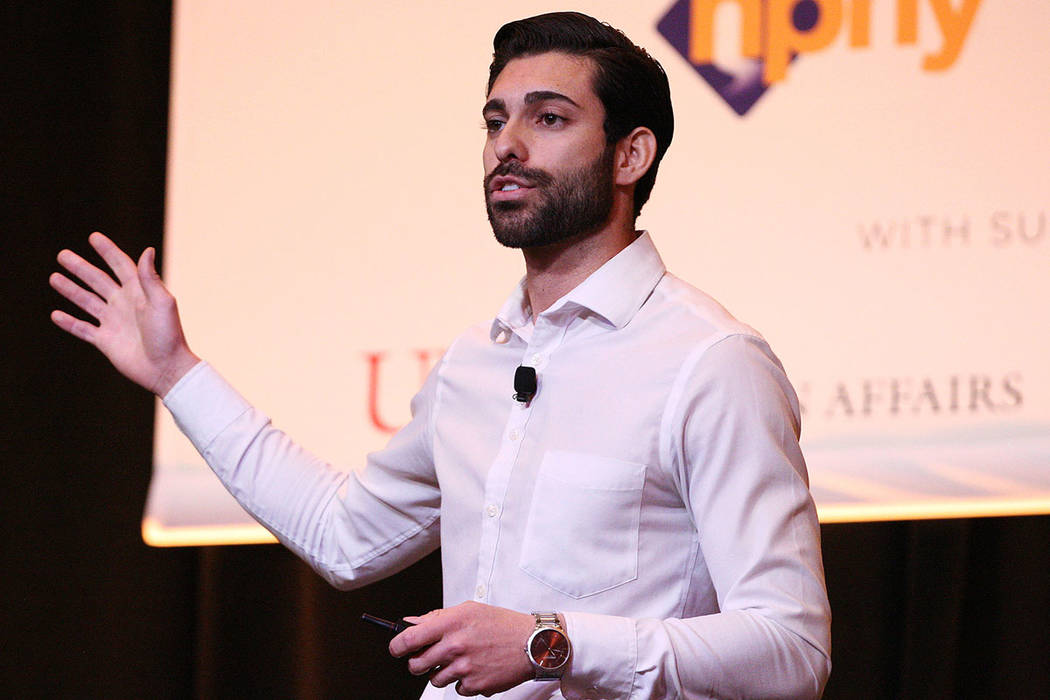Former homeless Las Vegas teen spotlights ongoing issue

Giuseppe Pizano was a freshman at Chaparral High School when he became homeless.
He had a heated argument with his mother when she told him he wouldn’t amount to anything, Pizano said. Later, as he approached his house after school, he found the front door locked. He peered through the windows and saw everything was gone.
For the next year, high school bleachers became his home. He stole food from 7-Eleven, brushed his teeth in a fountain and joined after-school programs to stay off the street.
Today, Pizano works for a technology company in Denver and speaks at schools; he recently gave his first TED Talk to encourage people to look at homelessness differently.
“I consider myself lucky because I had a backpack,” he said at a TED Talk in June in Traverse City, Michigan. “And because along the way I found some of the most beautiful, compassionate and courageous people that not only helped me through this time but who have left a lasting impression stamped on my heart.”
Pizano initially didn’t want to ask for help because he feared the foster care system and police, he said.
“I figured, staying homeless, I had more control over what happened in my life,” Pizano said.
With the help of one of his teachers, he landed at the Nevada Partnership for Homeless Youth.
Homeless stigma
Arash Ghafoori, executive director for NPHY, said youth often hide their homelessness because it carries a stigma.
“Homeless youth are an invisible population,” Ghafoori said. “They aren’t trying to advertise the fact that they are homeless. They aren’t trying to get bullied.”
Nevada ranked first in the nation for the rate of unaccompanied homeless children and youth living unsheltered on its streets, at 82 percent, according to the U.S. Department of Housing and Urban Development’s 2016 Annual Homeless Assessment Report.
There is an average of 2,052 unaccompanied homeless children in Nevada, according to the 2017 Southern Nevada Homeless Census and Survey. Ghafoori said the number is underestimated.
Even if every local homeless service provider tried to house every homeless child, he said, the local system could host less than 20 percent of that population.
“We have a lot of youth in the school district, we have a lot of youth on the streets, and a lot of youth in care, but we don’t have nearly enough beds to accommodate the population,” Ghafoori said.
The environment of Las Vegas also contributes to the issue of homelessness, Ghafoori said. He named warm weather, the 24/7 nature of the city and a lack of good public transportation as contributing factors. According to Help Home Hope, a Southern Nevada’s regional plan to end homelessness, one in every three teens on the streets will be lured into prostitution within 48 hours of leaving home.
A Safe Place
NPHY has locations in Henderson, northwest Las Vegas and the UNLV corridor. The number of first-time visits has increased by 7 percent this year, and the number of repeat visits has increased by 22 percent, Ghaffori said.
Out of nearly 500 youths to visit an NPHY center, 234 had ZIP codes that could be reported. Six of them were from Henderson.
NPHY offers programs such as emergency shelter, independent living, outreach, and a drop-in center. The drop-in center provides a home-like environment for youth where they can do homework, eat, exercise and interact with others.
NPHY operates the Safe Place program in Southern Nevada. The yellow signs associated with the program can be seen on buses and at fire departments and Terrible Herbst gas stations. Youths can come to Safe Place 24/7 if they suddenly end up homeless because of domestic abuse or other issues.
“Youth can become homeless suddenly and unpredictably, in a matter of a second,” Ghafoori said.
Program coordinators also go to schools, parks and recreation centers to try to find homeless youth. Many of them are what Ghafoori calls “service-resistant,” meaning they’ve been abused by adults or institutions, he said.
Typically, when participants first come to the programs, they are frightened because of past trauma, Ghafoori said.
“The trauma that they’ve suffered is immense,” he said. “The victimization that they’ve suffered is immense. And when they come here, it’s a journey.”
Success stories
Pizano isn’t the only participant of the Safe Place program who has found success. Others have thrived academically and professionally, Ghafoori said. Some are in the UNLV School of Architecture; others have been accepted to Ivy League schools or work at Las Vegas companies.
“I always say that the next person who comes here could be the next Michelle Obama, could be Picasso, could be Einstein, could be the next … president,” he said.
“… We want these kids to be able to chase their dreams.”
Pizano credited NPHY for teaching him how to take care of himself. Staff members celebrated his birthdays with him and cheered him on when he was running track in high school.
“They were my first real family,” Pizano said.
Pizano hopes to become a full-time motivational speaker.
“I want people to understand that it’s not always a choice,” he said. “These kids, most of the time, don’t choose to be on the streets. There’s an underlying factor. When there’s no role model, they don’t see any other opportunity other than drugs, smoking and streets.
“It’s really up to us as Americans to come together and help these kids to get out of this crappy situation.”
Contact Daria Sokolova at dsokolova@viewnews.com or 702-383-0496. Follow @DariaSokolova77 on Twitter.